Introduction

If you found yourself underwhelmed by the performance that the 9800 GX2 provided, Nvidia's new GeForce 9800 GTX could be the graphics card for you with its lower price point and single GPU.
We're not expecting the GTX to be faster than the GX2 by any means but hopefully we see it perform well against it as well as showing some competiveness against AMD's HD 3870 X2 and the overclocked 8800 GT which gives us similar numbers to the standard clocked G92 8800 GTS 512MB.
Initial pricing on the 9800 GTX looks promising; down under we should see it pop up for under $500 AUD which puts it into a bracket that doesn't really exist at the moment.
For roughly 15% more (sometimes less) in the money department you can get yourself an HD 3870 X2 and this really is going to be the GTX's toughest competition. While the X2 may be a dual GPU card it doesn't carry the excessive price tag that we see on NVIDIA's dual GPU card, the GeForce 9800 GX2. We all know these dual cards don't always provide great performance in all games due to untweaked driver support, so our tests today should be rather interesting indeed.
With a graphics card and driver CD only, once again provided anonymously, but without letter this time, we will check out the GeForce 9800 GTX in all its glory before we get into the all important benchmarks.
The Card
Like most high-end NVIDIA graphics cards these days, the front is taken up completely by a cooler that spans from one end to another. The cooler really resembles that of the 8800GTS 512MB with a few aesthetic changes.
Instead of being square at the end we see it kind of curves around the back and has an all round smoother finish. We also see the same fan design as the 8800GTS 512MB, which is also seen on the 9800 GX2.
What was kind of surprising is that if you make your way around the card you find yourself with two 6-pin PCI Express power connectors. We really thought that the card would only require a single connector but we were mistaken. The problem is that with support for three-way SLI (which means you have the ability to have three of these bad boys) a total of no less than six PCI Express power connectors are needed. Considering that most power supplies only have four at most you're probably going to run into some troubles unless you have Molex power adapters on hand.
Continuing across the top of the GTX we find two SLI connectors, which is something we haven't seen in a while with the 9600GT, 9800GX2, 8800GTS 512MB and 8800GT all only having a single SLI connector but this is not without reason.
The second SLI connector provides the ability to run three cards together if you have a supporting SLI motherboard such as NVIDIA's new NForce 790i Ultra SLI boards. If you find yourself with one of those three-way connectors in your 780i board and have been holding out for the GeForce 9 series, it might be time to pull that connector out of the box and make use of it. It is something we will investigate more later.
Finally we have the I/O side of things which unlike the GX2 doesn't hold any surprises. We've got nothing more than the standard two Dual Link DVI connectors and a single TV-Out port.
Specifications
As you would expect with all new cards, GPU-Z doesn't always like to play nice. The good news is though we get some of the more important information like core, memory and shader clocks as you can see below. We removed the vendor ID information to protect whoever sent us this product which is normal for our early look articles.
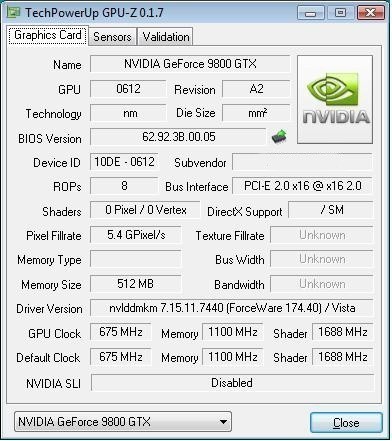
The core is at a healthy 675MHz, which gives us a 1688MHz shader clock. What's nice though is the whopping 2200MHz DDR that we get on the memory clock.
As far as other spec goes on the card we have 512MB of GDDR3 memory, 256-bit memory bus and 128 Stream processors. Spec wise it's quite similar to the G92 8800GTS bar the clocks which get a bit of an increase over the standard reference clocked G92 8800GTS 512MB which had 650MHz core clock, 1625MHz shader clock and a 1940MHz DDR memory clock.
Benchmarks - Test System Setup and 3DMark06
Test System Setup
Processor(s): Intel Core 2 Quad Q6600 @ 3GHz (333MHz x 9)
Cooling: Corsair Nautilus500 (Supplied by Corsair) with Arctic Cooling MX-2 Thermal Compound (Supplied by Arctic Cooling)
Motherboard(s): GIGABYTE X48-DQ6 (Supplied by GIGABYTE)
Memory: 2 X 1GB Kingston PC6400 DDR-2 3-3-3-10 (KHX6400D2ULK2/2G) (Supplied by Kingston)
Hard Disk(s): Seagate 250GB 7200RPM SATA-2 7200.10 (Supplied by Seagate)
Operating System: Windows XP Professional SP2 and Windows Vista SP1
Drivers: ATI Catalyst 8.3, ForceWare 174.53 (9 Series) and ForceWare 169.25 (8 Series)
With the new GeForce 9800 GTX in hand, it was clear what we had to compare it against.
We wanted to see just how much extra performance the GX2 offers over the GTX, we also wanted to see how the GTX faired against the HD 3870 X2 which really sits at the same price. We've also got the overclocked 8800GT which performs pretty much on par with a stock clocked 8800GTS.
Alright then, I think we are ready. Let's see how we go.
3DMark06
Version and / or Patch Used: Build 110
Developer Homepage: http://www.futuremark.com
Product Homepage: http://www.futuremark.com/products/3dmark06/
Buy It Here
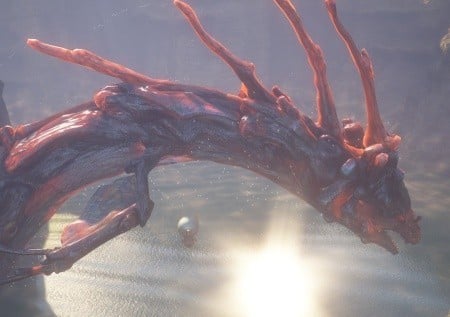
3DMark06 is the very latest version of the "Gamers Benchmark" from FutureMark. The newest version of 3DMark expands on the tests in 3DMark05 by adding graphical effects using Shader Model 3.0 and HDR (High Dynamic Range lighting) which will push even the best DX9 graphics cards to the extremes.
3DMark06 also focuses on not just the GPU but the CPU using the AGEIA PhysX software physics library to effectively test single and Dual Core processors.
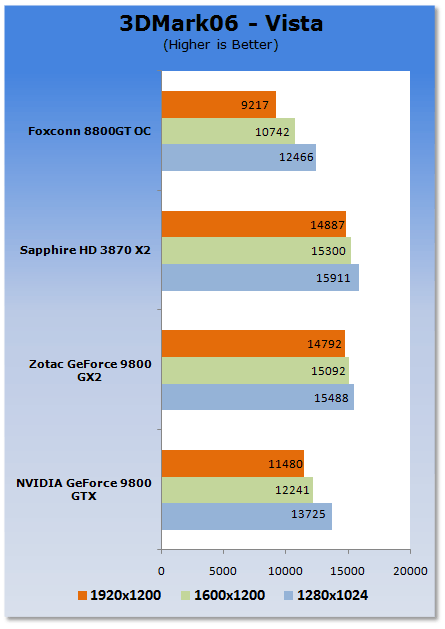
Straight away at the higher resolution we can see some decent gains over the 8800GT OC. At the lower resolution it's only just behind the dual GPU offerings from NVIDIA and AMD, only at the higher resolution does it really begin to fall back.
Benchmarks - PT Boats: Knights of the Sea
PT Boats: Knights of the Sea
Version and / or Patch Used: Benchmark Demo
Developer Homepage: http://en.akella.com/
Product Homepage: http://www.pt-boats.net/
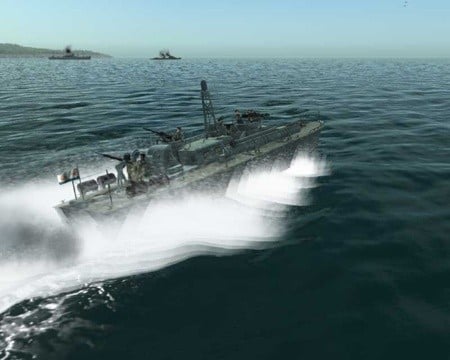
PT Boats: Knights of the Sea is a naval action simulator that places gamers in charge of a mosquito fleet of the Allied Forces, Russia or Germany during the height of World War II.
Using the latest Direct X 10 technology PT Boards - Knights of the Sea manages to apply a lot of stress to the components of today which in turn gives us quite an intensive benchmark.

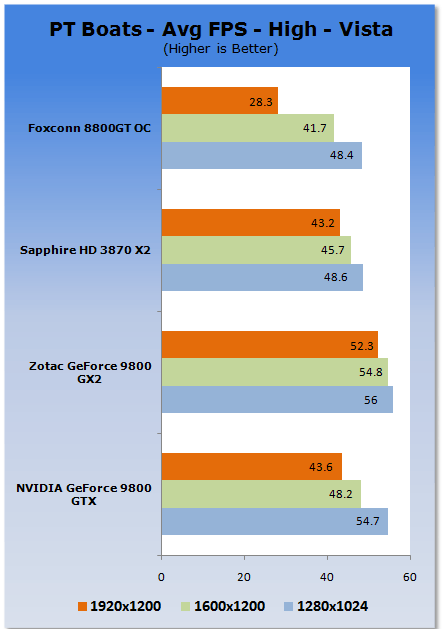
In the minimum department we can see that the GTX is able to keep up with the GX2 but when you compare the performance in the average department the GX2 is able to show good gains over the GTX at the higher resolution.
We can see that across the board the GTX is able to outperform the HD 3870 X2.
Benchmarks - CINEBENCH R10
CINEBENCH R10
Version and / or Patch Used: Release 10
Developer Homepage: http://www.maxon.net/
Product Homepage: http://www.maxon.net
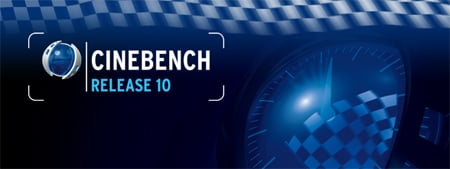
CINEBENCH is a real-world test suite that assesses your computer's performace capabilities. MAXON CINEBENCH is based on MAXON's award-winning animation software, CINEMA 4D, which is used extensively by studios and production houses worldwide for 3D content creation. MAXON software has been used in blockbuster movies such as Spider-Man, Star Wars, The Chronicles of Narnia and many more.
MAXON CINEBENCH runs several tests on your computer to measure the performance of the main processor and the graphics card under real world circumstances. The benchmark application makes use of up to 16 CPUs or CPU cores and is available for Windows (32-bit and 64-Bit) and Macintosh (PPC and Intel-based).

Under CINEBENCH we can see that the GTX sits a little bit back and doesn't offer any real performance increase compared to the other cards.
Benchmarks - Half Life 2 (Episode Two HDR)
Half Life 2 (Episode Two HDR)
Version and / or Patch Used: Latest from Steam
Timedemo or Level Used: Custom Timedemo
Developer Homepage: http://www.valvesoftware.com
Product Homepage: http://www.half-life2.com
Buy It Here
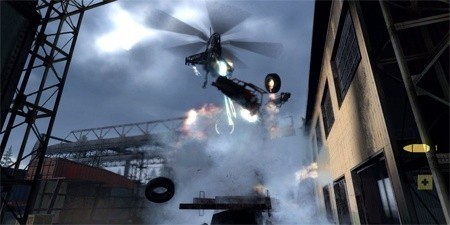
By taking the suspense, challenge and visceral charge of the original, and adding startling new realism, responsiveness and new HDR technology, Half-Life 2 Episode Two opens the door to a world where the player's presence affects everything around him, from the physical environment to the behaviors even the emotions of both friends and enemies.
We benchmark Half Life 2 Episode Two with our own custom timedemos as to avoid possible driver optimizations using the "record demo_name" command and loading the timedemo with the "timedemo demo_name" command - For a full list of the commands, click here.
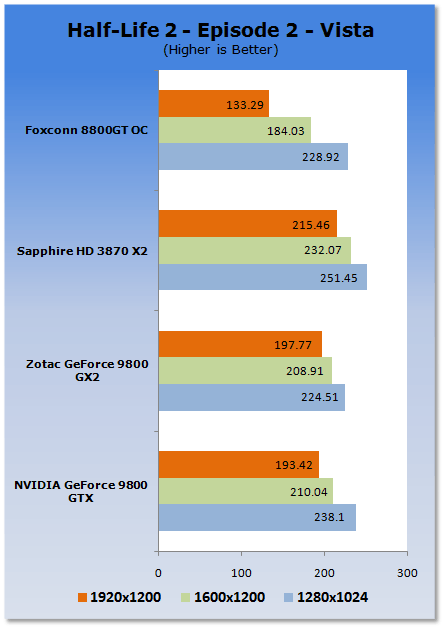
Moving to our first real-world game, we can see that the GTX is able to perform again on par with the dual core 9800 GX2. The HD 3870 X2 manages to hold a decent lead thanks to the good performance AMD based cards get under the Source based engine.
Benchmarks - World in Conflict
World in Conflict
Version and / or Patch Used: 1.0.0.5
Timedemo or Level Used: Built-in Test
Developer Homepage: http://www.massive.se
Product Homepage: http://www.worldinconflict.com
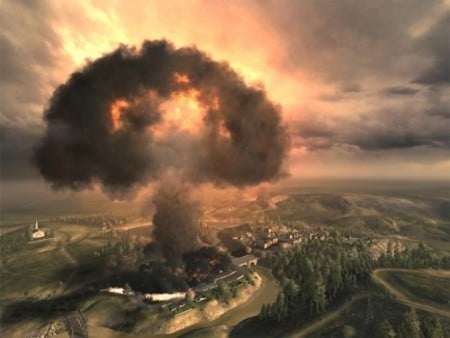
World in Conflict is a real-time strategy video game by Massive Entertainment and to be published by Sierra Entertainment for Windows (DX9 and DX10) and the Xbox 360.
The game is set in 1989 where economic troubles cripple the Soviet Union and threaten to dissolve it. However, the title pursues a "what if" scenario where, in this case, the Soviet Union does not collapse and instead pursues a course of war to remain in power. It is an intensive new game is sure to put plenty of stress on even the latest graphics cards and we use the built-in benchmarking for our testing.

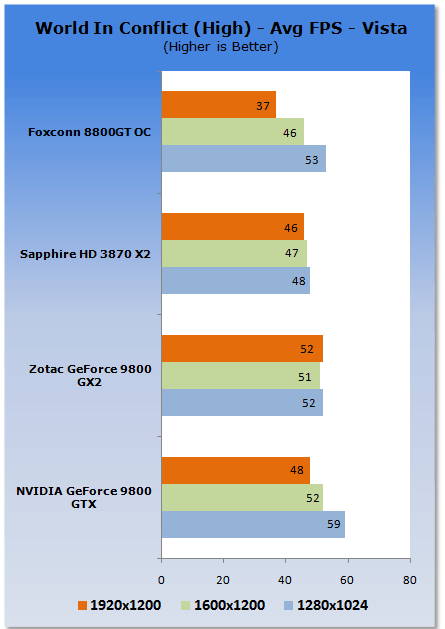
We continue to see that the GTX can really hold its ground against the much more expensive GX2 across the board with the GTX actually coming out ahead at the lower resolution.
Benchmarks - Enemy Territory: Quake Wars
Enemy Territory: Quake Wars
Version and / or Patch Used: Latest Steam Version
Timedemo or Level Used: Custom Timedemo
Developer Homepage: http://www.splashdamage.com/
Product Homepage: http://www.enemyterritory.com/
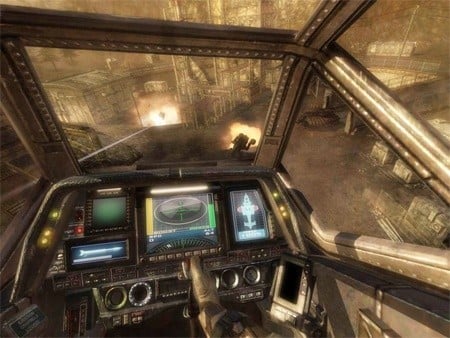
Enemy Territory: Quake Wars is the latest Quake incarnation to make it out of the iD labs and carries with it a fast paced experience that manages to place a good amount of strain on your graphics card.
We use a custom made time demo which shows a bit of everything and manages to give us a good solid benchmark for the graphics cards that we test.

Moving to Quake Wars at the lower resolution we can see all cards are quite bunched together, only when we get to 1920 x 1200 do we see the 8800GT OC drop back slightly.
Benchmarks - Crysis
Crysis
Version and / or Patch Used: 1.1
Timedemo or Level Used: Custom Timedemo
Developer Homepage: http://www.crytek.com/
Product Homepage: http://www.ea.com/crysis/
Buy It Here
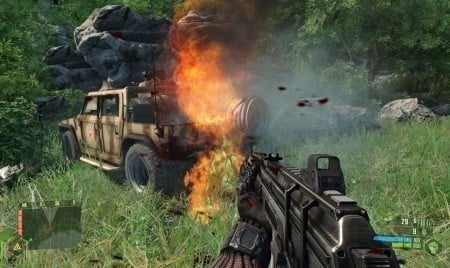
From the makers of Far Cry, Crysis offers FPS fans the best-looking, most highly-evolving gameplay, requiring the player to use adaptive tactics and total customization of weapons and armor to survive in dynamic, hostile environments including Zero-G.
Real time editing, bump mapping, dynamic lights, network system, integrated physics system, shaders, shadows and a dynamic music system are just some of the state of-the-art features the CryENGINE™ 2 offers. The CryENGINE™ 2 comes complete with all of its internal tools and also includes the CryENGINE™ 2 Sandbox world editing system.

Low resolution performance in Crysis like WIC is actually better on the 9800 GTX when compared to the GX2. As we climb up we can see the GX2 is able to pull ahead but only slightly. Not enough to justify the high cost though. We can also see some pretty good gains against the 8800GT at the higher resolution.
Benchmarks - Unreal Tournament 3
Unreal Tournament 3
Version and / or Patch Used: 1.1
Timedemo or Level Used: Custom Timedemo
Developer Homepage: http://www.epicgames.com/
Product Homepage: http://www.unrealtournament3.com/
Buy It Here
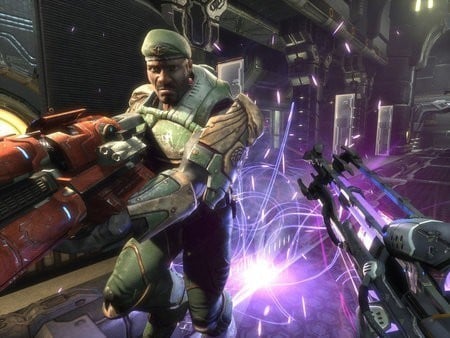
Following the formulae that made Unreal Tournament so great the third installment to the series has hit us recently with better than ever graphics. The games uses the latest Unreal Engine which like most modern day games when maxed out puts the pressure on our lineup of graphics cards.

Unreal Tournament 3 gives us that bouncy result that isn't all that uncommon. On a whole performance between the dual GPU offerings and the 9800 GTX are pretty close to each other.
Benchmarks - High Quality AA and AF
High Quality AA and AF
Our high quality tests let us separate the men from the boys and the ladies from the girls. If the cards weren't struggling before they will start to now.
3DMark06
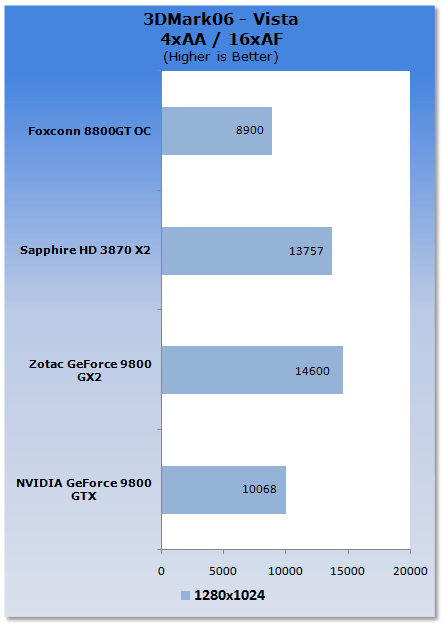
Turning on AA and AF we can see that the GX2 is able to leap ahead of the GTX offering almost a 50% gain in performance. The HD 3870 X2 runs about 35% faster while the 8800GT OC sits about 10% behind.
Half Life 2 (Episode Two HDR)

We again see the 9800 GTX fall behind a fair bit. The HD 3870 X2 continues to give a good boost in performance while we still see a decent jump ahead of the 8800GT OC.
World In Conflict


Moving to WIC we can see that again in the minimum department the dual GPU cards and the 9800 GTX perform quite close together, when you look at the averages though the GX2 manages to pull ahead by about 20%.
Benchmarks - 3DMark06 - XP
3DMark06
Version and / or Patch Used: Build 110
Developer Homepage: http://www.futuremark.com
Product Homepage: http://www.futuremark.com/products/3dmark06/
Buy It Here

3DMark06 is the very latest version of the "Gamers Benchmark" from FutureMark. The newest version of 3DMark expands on the tests in 3DMark05 by adding graphical effects using Shader Model 3.0 and HDR (High Dynamic Range lighting) which will push even the best DX9 graphics cards to the extremes.
3DMark06 also focuses on not just the GPU but the CPU using the AGEIA PhysX software physics library to effectively test single and Dual Core processors.

Moving over to XP we have a pretty similar picture to what we've seen so far with the GTX showing some decent gains over the 8800GT OC and it performing pretty close behind the X2 and GX2 at the lower resolutions to it to only fall back at the higher ones.
Benchmarks - CINEBENCH R10 - XP
CINEBENCH R10
Version and / or Patch Used: Release 10
Developer Homepage: http://www.maxon.net/
Product Homepage: http://www.maxon.net

CINEBENCH is a real-world test suite that assesses your computer's performace capabilities. MAXON CINEBENCH is based on MAXON's award-winning animation software, CINEMA 4D, which is used extensively by studios and production houses worldwide for 3D content creation. MAXON software has been used in blockbuster movies such as Spider-Man, Star Wars, The Chronicles of Narnia and many more.
MAXON CINEBENCH runs several tests on your computer to measure the performance of the main processor and the graphics card under real world circumstances. The benchmark application makes use of up to 16 CPUs or CPU cores and is available for Windows (32-bit and 64-Bit) and Macintosh (PPC and Intel-based).

The GTX has managed to even out with the X2 and 8800GT in CINEBENCH under XP and we see the GX2 actually fall back a little.
Benchmarks - World in Conflict - XP
World in Conflict
Version and / or Patch Used: 1.0.0.5
Timedemo or Level Used: Built-in Test
Developer Homepage: http://www.massive.se
Product Homepage: http://www.worldinconflict.com

World in Conflict is a real-time strategy video game by Massive Entertainment and to be published by Sierra Entertainment for Windows (DX9 and DX10) and the Xbox 360.
The game is set in 1989 where economic troubles cripple the Soviet Union and threaten to dissolve it. However, the title pursues a "what if" scenario where, in this case, the Soviet Union does not collapse and instead pursues a course of war to remain in power. It is an intensive new game is sure to put plenty of stress on even the latest graphics cards and we use the built-in benchmarking for our testing.
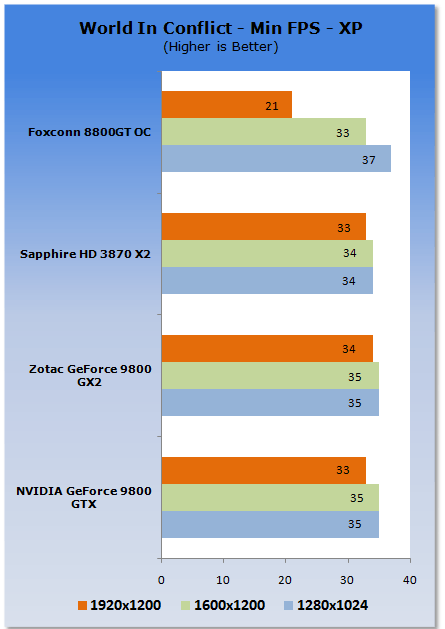

WIC under XP gives us similar numbers with the minimum numbers between the dual cored cards and the GTX being quite similar and the average numbers at the higher resolution going to the X2 and GX2.
Benchmarks - Unreal Tournament 3 - XP
Unreal Tournament 3
Version and / or Patch Used: 1.1
Timedemo or Level Used: Custom Timedemo
Developer Homepage: http://www.epicgames.com/
Product Homepage: http://www.unrealtournament3.com/
Buy It Here

Following the formulae that made Unreal Tournament so great the third installment to the series has hit us recently with better than ever graphics. The games uses the latest Unreal Engine which like most modern day games when maxed out puts the pressure on our lineup of graphics cards.
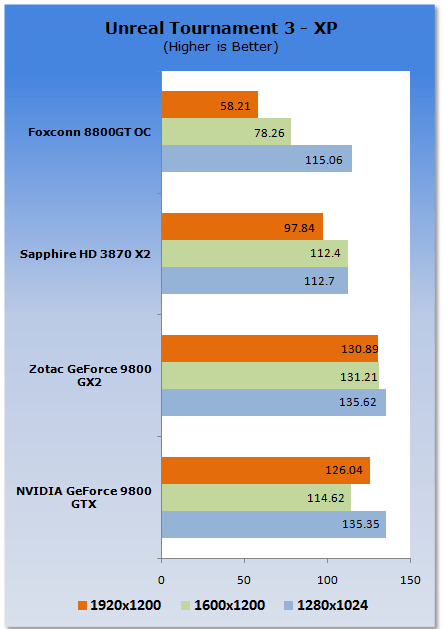
We again see that up down up configuration on our graph making low and high resolution performance pretty much on par with the GX2 and ahead of the X2.At the highest resolution we can see big gains for the GTX over the 8800GT.
Benchmarks - Half Life 2 (Episode Two HDR) - XP
Half Life 2 (Episode Two HDR)
Version and / or Patch Used: Latest from Steam
Timedemo or Level Used: Custom Timedemo
Developer Homepage: http://www.valvesoftware.com
Product Homepage: http://www.half-life2.com
Buy It Here

By taking the suspense, challenge and visceral charge of the original, and adding startling new realism, responsiveness and new HDR technology, Half-Life 2 Episode Two opens the door to a world where the player's presence affects everything around him, from the physical environment to the behaviors even the emotions of both friends and enemies.
We benchmark Half Life 2 Episode Two with our own custom timedemos as to avoid possible driver optimizations using the "record demo_name" command and loading the timedemo with the "timedemo demo_name" command - For a full list of the commands, click here.
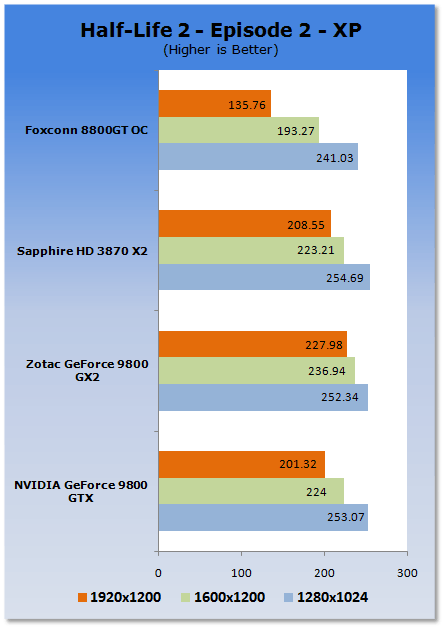
Finally we leave with Half Life 2 and we again see the GX2 is just able to sneak ahead of the GTX at the higher resolutions. Under XP though the HD 3870 X2 doesn't get the gains over the competition like it did under Vista.
Temperature and Sound Tests
Temperature Tests
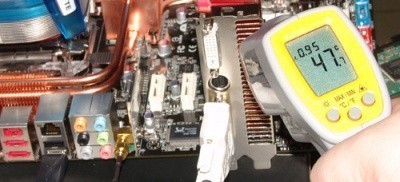
With the TES 1326 Infrared Thermometer literally in hand we found ourselves getting real-world temperatures from the products we test at load (3D clock speeds).
There are two places we pull temperature from - the back of the card directly behind the core and if the card is dual slot and has an exhaust point we also pull a temperate from there, as seen in the picture.

The large cooler manages to do a good job of keeping the card temperature down with it coming below all cards including the 8800GT.
Sound Tests
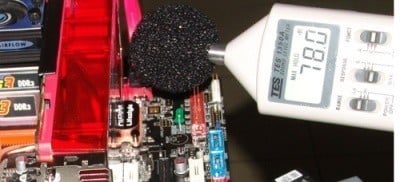
Pulling out the TES 1350A Sound Level Meter we find ourselves quickly yelling into the top of it to see how loud we can be.
After five minutes of that we get a bit more serious and place the device two CM away from the fan on the card to find the maximum noise level of the card when idle (2D mode) and in load (3D mode).
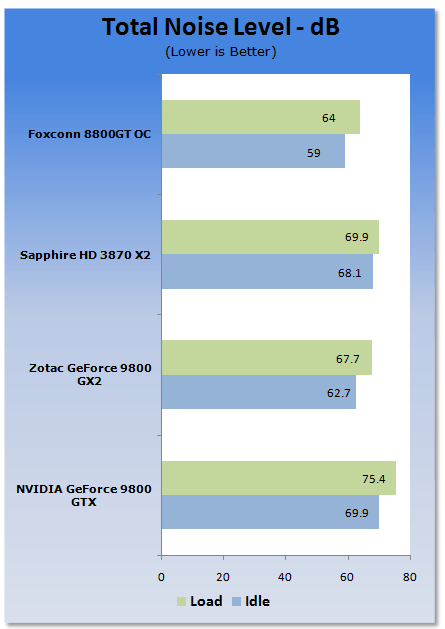
Unfortunately this lower temperature comes at the cost of extra dB at both idle and load.
Power Consumption Tests
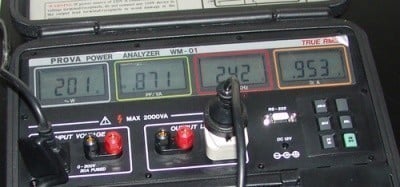
Using our new PROVA Power Analyzer WM-01 or "Power Thingy" as it has become quickly known as to our readers, we are now able to find out what kind of power is being used by our test system and the associated graphics cards installed. Keep in mind; it tests the complete system (minus LCD monitor, which is plugged directly into AC wall socket).
There are a few important notes to remember though; while our maximum power is taken in 3DMark06 at the same exact point, we have seen in particular tests the power being drawn as much as 10% more. We test at the exact same stage every time; therefore tests should be very consistent and accurate.
The other thing to remember is that our test system is bare minimum - only a 7,200RPM SATA-II single hard drive is used without CD ROM or many cooling fans.
So while the system might draw 400 watts in our test system, placing it into your own PC with a number of other items, the draw is going to be higher.
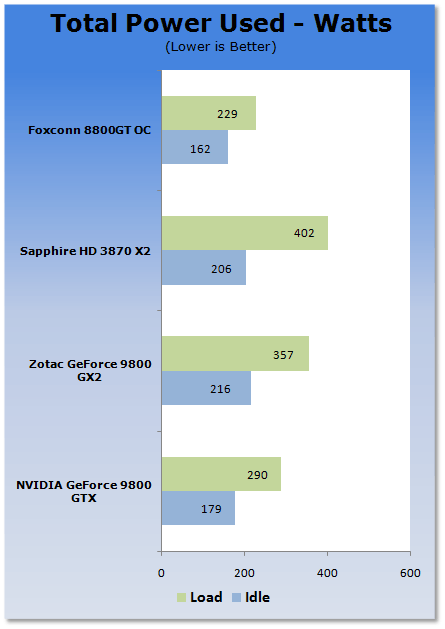
Power draw seems to sit in line with what you would expect, higher than the GT but lower than the GX2. Of course, it's considerably lower than the HD 3870 X2.
Final Thoughts
We have to say going into the review of the GeForce 9800 GTX, we weren't expecting a lot. We are quite a fan of the GeForce 9800 GX2 but when we sit down and wonder if we would spend our hard earned money on it, you tend to think of the product in a different perspective. A week ago you couldn't go past the 9800 GX2 for the plain fact that it was the fastest graphics card on the market. Quad SLI also showed potential in games that are able to make full use of the technology like Crysis at the higher resolutions.
Even though this is one of our typical early tests using drivers available at the time of testing, NVIDIA's 9800 GTX is a fantastic product - at times it's even able to perform on par with the GX2 and sometimes even better if the game isn't able to make full use of SLI technology. What makes the GTX so attractive though is the price point - although, we must say that, when push comes to shove, the choice to not spend slightly more on the HD 3870 X2 is going to be a hard one to make, if you are neither an AMD nor NVIDIA fan. With the advancements AMD make in its Catalyst drivers every month, you have to wonder in two months time how the HD 3870 X2 and new GTX are going to fair against each other.
If you've set a strict budget of $500 or under the GeForce 9800 GTX is going to be the graphics card of choice. If you find yourself though being tempted to spend more, the Radeon HD 3870 X2 is probably going to quickly become a real possibility with all the numbers considered.
Stepping it up a notch or two, what we really need to know now is how not only three-way SLI goes but normal SLI as getting a pair of 9800 GTX cards should be only a little more expensive than a single 9800 GX2. The only problem is that you will require an SLI motherboard, which if you're a happy owner of an X38 or P35 based motherboard, might be a little hard to swallow a yet another upgrade, when you have a perfectly capable board already.
The GTX is a great single GPU graphics card which is pretty much going to halt any future purchases on the G92 8800GTS but it is not revolutionary, which is what a new naming scheme should be as far as we are concerned. If you were hoping for some really huge improvements over the 8800GTS, you'll have to wait for Nvidia's new technology.

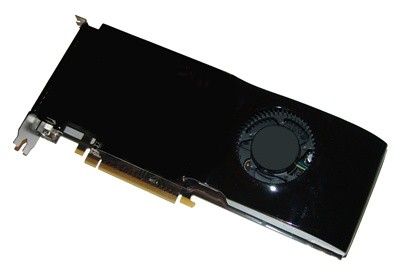
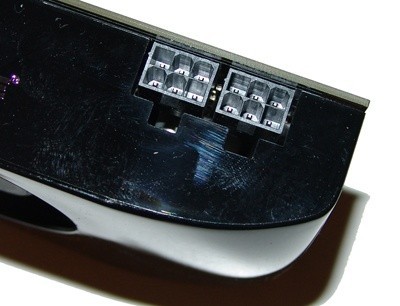
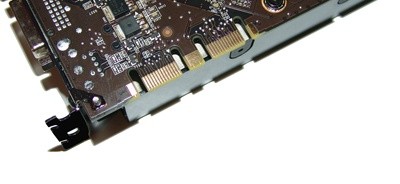
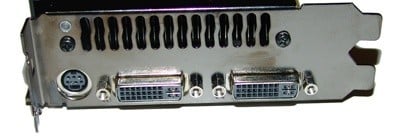
 United
States: Find other tech and computer products like this
over at
United
States: Find other tech and computer products like this
over at  United
Kingdom: Find other tech and computer products like this
over at
United
Kingdom: Find other tech and computer products like this
over at  Australia:
Find other tech and computer products like this over at
Australia:
Find other tech and computer products like this over at  Canada:
Find other tech and computer products like this over at
Canada:
Find other tech and computer products like this over at  Deutschland:
Finde andere Technik- und Computerprodukte wie dieses auf
Deutschland:
Finde andere Technik- und Computerprodukte wie dieses auf